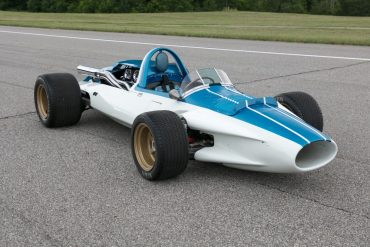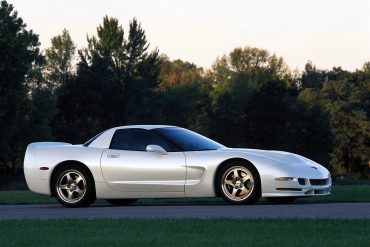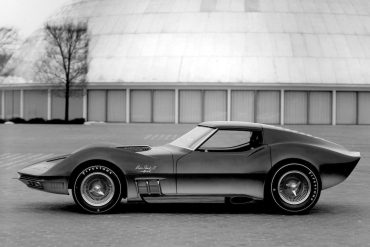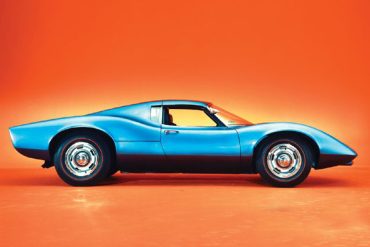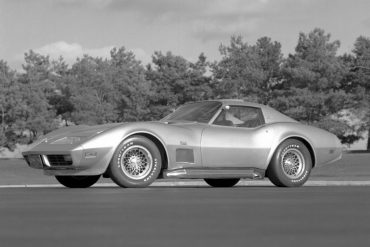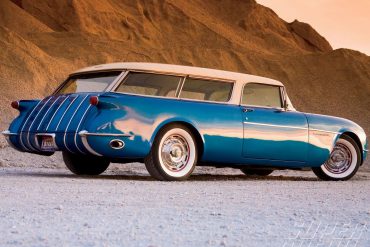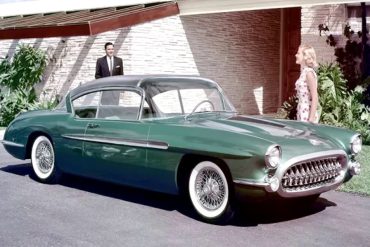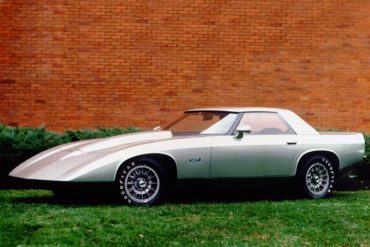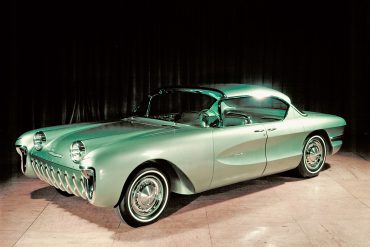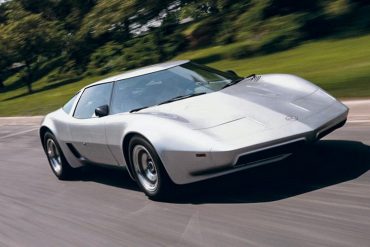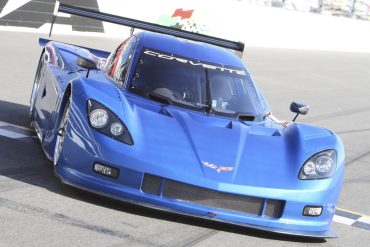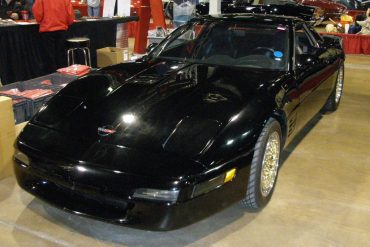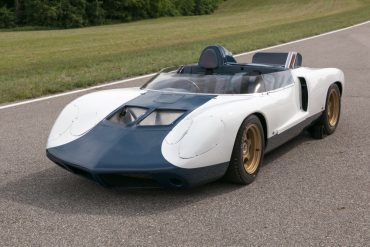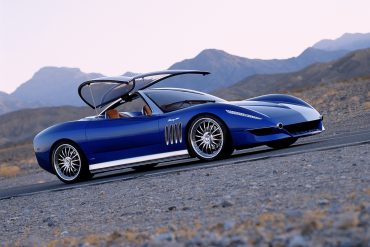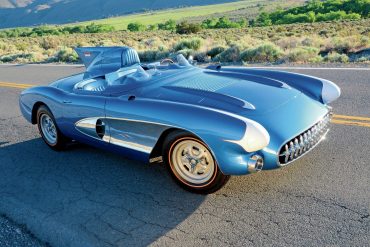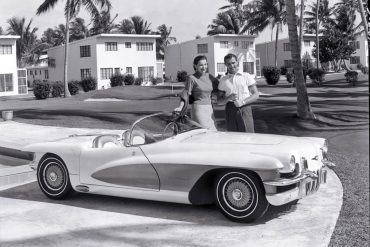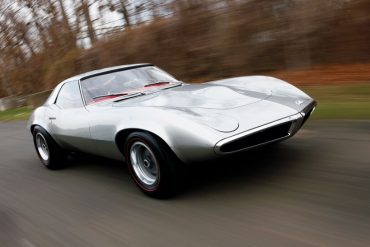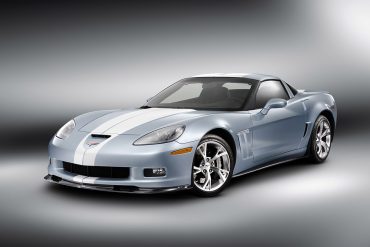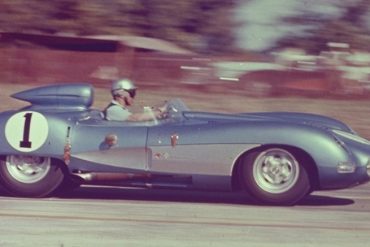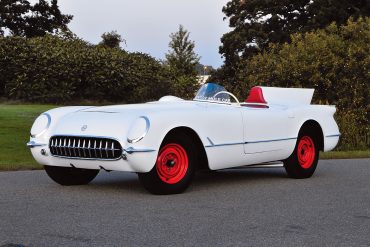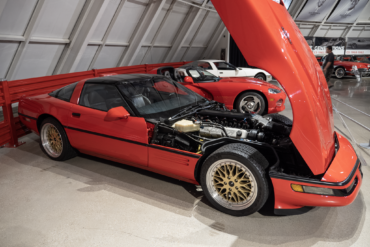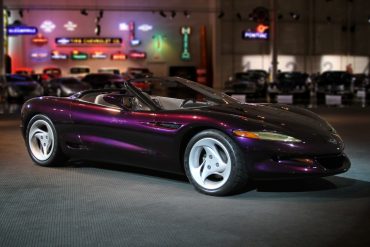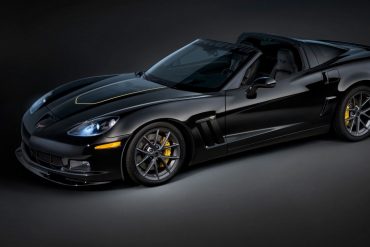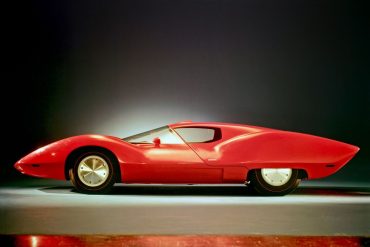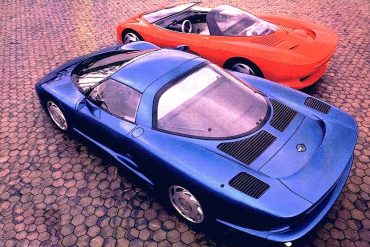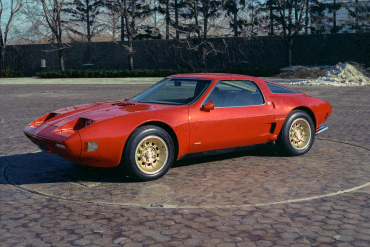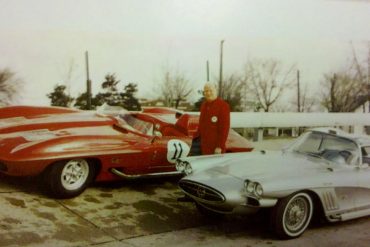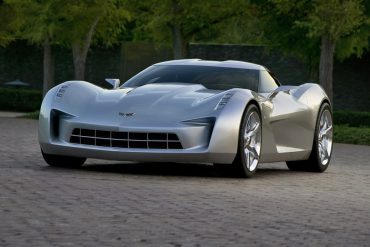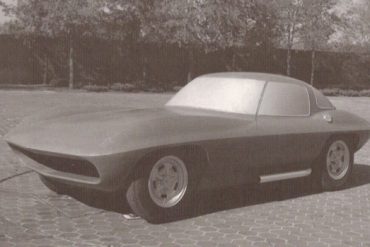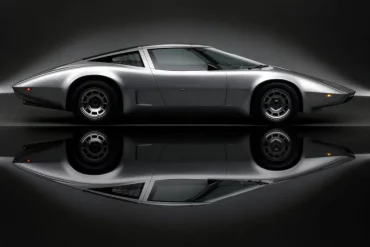The “CERV-1” (Chevrolet Engineering Research Vehicle) was developed as a research tool for that company’s continuous investigations into automotive ride and handling phenomena under the most realistic conditions. The car was built at the Chevrolet Engineering Center at Warren, Michigan in a special project headed by Mr. Zora Arkus-Duntov, Chevrolet Staff Engineer.
"Hot" is an apt description of this special coupe's drivetrain. Its 6.6-liter engine produces 512 horsepower and 523 lbs.-ft. of torque. Mated to a four-speed automatic transmission and featuring a 3:41 geared limited slip differential and four-wheel independent suspension, this "Vette takes a backseat to no other vehicle. The White Shark Corvette also features power rack-and-pinion steering to precisely pilot this vehicle and four-wheel disc brakes with ABS.
The Mako Shark II was a radical concept that shaped Stingray years later. While showcasing distinct design cues, the Mako Shark contained many notable features for 1965. It had a one-piece front-end that hinged forward for access to the engine bay, a removable hardtop, knock-off aluminum wheels and a big-block 427. Chevrolet received overwhelming requests to have it produced.
The Astro II was one of the most significant case studies of Duntov’s outright refusal to let his mid-engine dreams die, and as such, ultimately entered the history books as a precursor to the eventual mid-engine, C8 Corvettes of today. The Astro II was designed in a way that was more representative of the Corvette’s typical styling cues, than that of The Astro I.
Chevrolet Corvette Mulsanne Showcar, 1974. Created by Bill Mitchell, the Mulsanne was a development of several previous Corvette “specials”, the 1969 Aero and the 1970 Scirocco. By 1974 it had been bored out to 454 ci and fitted with an experimental Rochester fuel injection system, it also had a periscope rearview mirror system.
Carl Renner was responsible for the Nomad which was essentially a Corvette built with an extended station wagon roof. This meant the Corvette shared its lightweight fiberglass body, ‘Blue Flame’ inline-6 engine and curvaceous styling with the Nomad.
On July of 1955, the Chevrolet design studio staff created a dream car for the 1956 GM Motorama shows, called Corvette Impala. The Corvette grille and grille surround are incorporated, as well as other Corvette components. This hardtop five-passenger sports sedan shows the name "Corvette Impala" on the front emblem and rear license plate.
The 1973 Chevrolet XP-898 concept car was built with a frameless fiberglass foam sandwich body and chassis. This two-seater sports coupe offered a unique look at alternative engineering approaches to future techniques in design and manufacturing. The entire body consisted of four lightweight fiberglass outer body panels.
GM’s 1950s Motorama-mobiles were mostly pretty out-there, with flamboyant fins, rocket-inspired skegs and cockpits, and other flights of wild imagination. Frankly, many of them were a bit absurd and even childish. But there were a few that were somewhat down to earth, even rather brilliant, like this 1955 Chevrolet Biscayne.
The Chevrolet Aerovette (originally designated Experimental Project XP-882) was developed in the late 1960's under the watchful eyes and mind of Zora Arkus-Duntov. Unlike the XP-819, which ultimately proved to have too much rear weight bias, Duntov focused on developing the Aerovette as a mid-engine platform.
For the 2012 Grand-Am season, Chevrolet was the first to unveil it's new DPG3 bodywork. This Corvette body kit will be built by Pratt & Miller and will be sold to customer teams. These body kits will fit on any existing Coyote, Riley, or Dallara chassis. This Corvette DP will be powered by a 5.0L V8 making 530BHP @ 7,000rpms and 450ft-lbs at 5,500rpms.
CERV IV was nothing more than a C4 with the all new powertrain and interior in it. Read the commentary of a car magazine reporter: "We suspect that the first, very early prototypes of the all-new, Gen III ran on the dynos at GM Powertrain sometime in the early spring of 1993. In-vehicle testing began at the GM Milford Proving Ground in the first week in May of 1993 with the "Chevrolet Engineering and Research Vehicle IV-A".
The CERV II was entirely Zora’s car. The CERV II was conceived early in 1962 and developed over the next year, after the GS program was squashed. The car was built under Zora's direction between 1963-'64. Zora had it in mind to develop a separate line of racing Corvettes but the idea got terminated by management.
The Moray project, presented for the first time at the Geneva Motor Show on March 4, 2003, embodies the homage that Giorgetto and Fabrizio Giugiaro wish to pay to the fifty-year era of the Chevrolet Corvette, the supreme symbol of the American sports car. Touched by drifting tides with long and slender front lights, bringing immediately to mind the Moray, the English term for the eel-type fish, muraena helena, found in Mediterranean waters.
Designed mid-1956 for Harlet Earl’s son Jerry, the SR-2 was put into racing duty in 1957. The car debuted at Daytona Beach in 1957 with a high-speed canopy, fender skirts and bullet-shaped frond headlights. Driven by Betty Skelton and Buck Baker, the car won the modified class with an average speed of 93.074 mph. The SR-2 also finished second in class for the flying mile with a top speed of 152.886 mph.
The engineers came up with a unit-body construction that relied on strength coming from the side sills of the chassis. These contained the exhaust which probably easily overheated the cockpit, especially in the coupe. Unfortunately, GM fitted fake V6 engines in both cars with a concept valve train that included dual overhead camshafts.
When first introduced to the world by Pontiac in 1964, the car showed so much promise that Chevrolet (allegedly) put a swift end to its development to prevent its production from hindering the sales of the Corvette. Afterall, with the introduction of the 1963 Split-Window Corvette, Chevy was finally seeing an increase in sales, something lacking for most of the first-gen.
The Carlisle Blue Grand Sport Concept is painted in a very cool Carlisle Blue exterior with exquisite Pearl White full-length racing stripes. This color combination is highlighted with Silver-painted Torque 2 wheels. The Corvette also benefited from carbon fiber front splitter and rockers, a full-width rear spoiler, and a Grand Sport style hood blanket. For the interior, Chevrolet has opted for Ebony/Titanium leather with blue stitching, a new Bose Premium Audio with nine speakers.
The Corvette SS began life as an experimental race car, and was unveiled to the public at the 12 Hours of Sebring endurance race on March 23, 1957. The SS was in training for Chevrolet's debut at LeMans that year. The Sebring race was, in many ways, Chevrolet's inauguration into modern racing. But the SS never finished the race, much to the dismay of the racing community.
Built for outright top speed, this prototype Corvette was built by Zora Duntov. He successfully piloted the car to a two-way average speed of 150 mph in January of 1956 at Daytona. Later two more similar cars were built for the 1956 Daytona Speed Weeks in February. After initial resistance from Engineering, Duntov’s cam was delivered to the Proving Ground.
The Corvette team decided to one-up the Viper with four extra cylinders, they decided on one of Ryan Falconer’s stunning, all aluminum, 600-cubic-inch, 683hp, 680 lb-ft V-12 racing engines. The biggest challenge was the fact that the all-aluminum V-12 engine was 8.8-inches longer than the production Corvette engine. So the front end of the ZR-1 would have to be stretched 8 inches. This test car was named Conan, after his raw, beastlike charisma.
The Corvette Stingray Concept was developed as an internal design challenge to combine classic Corvette cues with surprisingly high-tech features, modern materials, and a striking new appearance. The car is well-appointed with a clamshell hood, scissor-style doors, ergonomic seats, rear-view camera with night vision enhancement, and a high performance hybrid drive. Interactive touch controls allow the driver to customize the power and efficiency of his or her ride.
The Corvette Jake Edition is a Grand Sport Coupe, with Z06 wheels featuring the Competition Gray finish. The matte Jake hood graphic from the GT1 commemorative model adds a subtle visual statement, while a host of other accessories round out the car’s unique appearance. Most of the parts added to this special Grand Sport are available today as Genuine Corvette Accessories or through any Chevrolet dealer’s parts department.
Those that have laid eyes on the Astro I will not soon forget it. This 1967 Chevrolet prototype featured sleek body lines that embodied the feel of a far more aggressively styled Mako Shark. Although the Astro I was built with the intent to aid in the study of aerodynamics, no official documentation has been uncovered as to the results of this testing.
While it was understood that the Corvette Indy Concept would never be fully realized as a production vehicle, it paved the way for the creation of the twin-turbo CERV III. The CERV III (Chevrolet Engineering Research Vehicle No. 3) was introduced in January, 1990 at the International Auto Show in Detroit, Michigan. Like the latter iteration of the Corvette Indy Concept car, the CERV III was fitted with a 5.7 Liter, 32-valve, dual-overhead cam LT5 engine that featured twin turbochargers. It had 650 hp and 655 lb/ft of torque and top speed of 225 mph.
This little concept mounted a 180-horse Wankel transversely, driving a new automatic transaxle being developed for the forthcoming X-body Citation. Designed by GM's Experimental Studio and built in 6 months on a modified Porsche 914 chassis by Pininfarina, the 2-Rotor made its debut at the 1973 Frankfurt show.
Designed and built under the personal supervision of Bill Mitchell, the wild-looking XP-700 used many regular Corvette components (frame, chassis parts and engine). Bill Mitchell had a lot of “customs” built for himself. This XP-700 previewed the new tail of the upcoming 1961 Corvette.
SIDESWIPE takes the form of a sleek, vision concept dreamed up by the Corvette designers at GM. The design is influenced by the original Stingray race car, introduced in 1959, but also draws on Corvette heritage cues from other generations. It brings them together in a futuristic shape that seems to be equal parts racecar and space ship.
Somewhere in the second part of 1959, project XP-720 begins at GM Styling, to design a production Corvette based on Bill Mitchell's Sting Ray racer. It would become known as the C2 or second generation Corvette. In October of that same year, a clay mock-up of project XP-720 is completed and put on display for General Motors' management viewing.
In 1977, GM chairman Thomas Murphy gave the Aero-vette the green light. It was approved for production, and slated to be released in 1980. Despite being greenlit for 1980 production as the upcoming C4 Corvette, Arkus-Duntov's replacement Dave McLellan decided for a number of reasons (cost and tradition among them) to stick with the Corvette's tried and true front-engine configuration
No More Content


